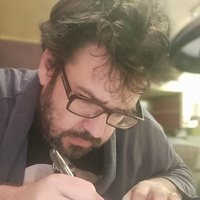On building an immersive world
Prelude
Ashley Brett Chipman has a background in directing, set design, dance, installation art and everything whimsical. She has worked in set decorating for film and television for over a decade for HBO, Apple and Netflix on projects ranging from M. Night Shyamalan’s Servant to Ryan Murphy’s American Horror Stories. Her love for world-building and her never-ceasing infatuation with the mystery surrounding Rasputin and Imperial Russia inspired her to create the immersive production The Death of Rasputin.
Conversation
On building an immersive world
Director and installation artist Ashley Brett Chipman discusses fostering audience participation, learning to be resourceful, and using set design to build worlds.
As told to Brittany Menjivar, 2075 words.
Tags: Art, Theater, Process, Promotion, Production, Collaboration, Income.
Before founding Artemis is Burning, the theater collective behind The Death of Rasputin, you worked as a set decorator for film and TV. You also have a dance background. How did you come to immersive theater?
I’ve always been well-rounded in the arts, moving between film, dance, and performance art. Lately I’ve been working in film, but I specifically like building worlds. Before I was first introduced to [famed immersive production] Sleep No More, I had a real interest in installation art; for my MFA, I built a shantytown structure with furniture and windows and doors and used projections to tell stories. Seeing installation art through a theatrical lens blew my mind. The sets that I build for the screen get demolished the next day; the idea that you could build a world that people could continuously exist in was so exciting to me.
When did you first feel the call of Rasputin’s story? How did you know that it would be a fit for the immersive theater environment?
I read a novel called The Last Tsar that talked extensively about Rasputin. I found it such a rich and fascinating subject, so I learned everything I could about the time period. It stood out to me as a world that you would want to be a part of, rather than watching it unfold in a film or miniseries. There were so many main characters, which is important in immersive theater. When you’re building an immersive piece, you can’t just write one story—you have to craft a narrative for each individual character and each individual space.
How did Artemis is Burning come together?
I had been chatting with my friends Julia Sharpe and Alex Campbell, both filmmakers and writers, about my idea. They wanted to work on the project, but we knew we needed people with theatrical experience—specifically, immersive experience. I had been following Hope Youngblood for a long time, and I thought her work was spectacular. So I reached out, and she said, “This sounds really cool.” Through her, I met Kelly Bartnett, who’s our main producer, and also my dear friend Allison Camali, who is a filmmaker as well. We wanted to bring a cinematic depth to theatrical immersive productions.
Could you tell me more about the writing process and rehearsal period?
We wrote a script for each character. Each character’s script has eleven scenes. Sometimes their scenes meet, and sometimes characters are doing scenes by themselves. We had all these matrices: characters by scene, characters by location. If you change one element of the script for one character, it changes everything for everyone else, so we tried to go in knowing as much as we could. At first, we thought each scene would be exactly seven minutes, but they ended up all being different. Thanks to our stage manager, Sarah Nichols, every minute is now accounted for.
We chose actors who we thought would collaborate with us; many had done immersive theater before, although some of them hadn’t. They all had a lot to bring to the table—years of experience in their fields and curiosity and excitement. They got to know their characters better than we ever could have.
Once we started rehearsals, we attacked the show from all sides—we did lines, we rehearsed the dance language with choreographer James Finnemore, and we guessed at how we could involve audience participation, because that’s something you don’t really get to practice until you have the audience in the room. We only had two dress rehearsals. We brought in friends here and there to get a read on the show, but it all really fell into place during the weeks leading up to it. We just had to trust our instincts.
Working out timing was a collaborative process—our composer needed to know the timing of the actors’ movements to write the score, but the actors needed to know the sound to do timing. Stephen Dobby, our composer, would send us a selection of music, and we would tell him if it was too long or too short. He put in a lot of cues throughout. For example, a rattle or bell sound might indicate that a scene has one minute left.
One difference between The Death of Rasputin and predecessors such as Sleep No More is that The Death of Rasputin doesn’t provide masquerade masks to conceal attendees’ identities. What inspired you to allow for face-to-face interaction?
I didn’t feel that masks were necessary for the form. If we chose to do masks, it might have seemed like we were copying Sleep No More—and we always envisioned that The Death of Rasputin would feel like a party. We wanted to encourage play. My hope was that you could make friends at the show—and if you’re behind a mask, you’ll never know [your fellow audience members]. We really wanted for there to be shared moments, so we have some dancing and other scenes that allow you to actually meet people. We also ask everyone to wear black so that the audience blends in a bit more seamlessly—it does the same thing that a mask does, in a different way.
For many fans, immersive theater is especially intoxicating because of the opportunity for audience participation that it offers. As the popularity of the art form increases, theater-makers face a unique challenge: they have to craft opportunities for select audience members to feel special while also ensuring that everyone who attends a given show has a fulfilling experience. The Death of Rasputin toes this line especially well. When you began conceptualizing the show, what was your vision for audience-actor interaction, and how did you execute it?
I really wanted to push the form and do more with it. I was inspired by parties with my friends where we would do things like play hide-and-go-seek in a mansion—things that brought us back to our childlike selves. We wanted people to let their guard down and participate. We’re all sick of phones and digital interactions.
We definitely have fewer one-on-ones than Sleep No More. Because of our scale, we had to ask, “How do we make the most of our resources—our space and our time and the actors’ time?” Really, we only have one one-on-one [audience member-actor interaction]; we have a few one-on-five or one-on-six interactions. Those are nice because they encourage a sense of collaboration among you and whoever else is in the room with you.
The Death of Rasputin offers a variety of unique merch items, including an original vial of perfume. How did this concoction come to be, and how did you determine which scents would transport wearers back to 1916 Petrograd as you imagined it?
Coming up with exciting merch was super fun for me. Everyone talks about how Rasputin smelled—most people know five facts about him, and one of them is that he smelled a certain way. I thought, “We have to sell his scent, because everybody’s going to want to know what that’s like.” I really like perfume and essential oils, so I was like, “I’ll figure this out.” At first, I tried to get the perfume as stinky as he probably was. I tried weird things like fish oil and musky scents, but it started to get too gross. The finished perfume actually smells really nice, but there’s a lot of alcohol in it, since we felt like he would be very booze-heavy. Vodka doesn’t have a very strong scent, so we went the whiskey route. Other elements include tobacco and pine. It was fun to think about the scents of that era—especially what they would have used in St. Petrograd and in Siberia.
You’ve been hosting special event nights for attendees before and after certain shows. One such event was a fanfiction reading. How did the reading go? And how has having such an enthusiastic fan base influenced your approach to the show?
The fans have been wonderful. They’re so invested in the show. They take notes; they know everything that we have planned. It makes us, the creators, really feel seen.
We wanted to include our fans in different ways throughout the show’s run. We had some of our own ideas and sourced some from the actors as well. It was Tim [Creavin], who played Iliodor, who brought this one up. He was in Sleep No More, and he knows the fans and knew that they would be really into this. We got quite the spectrum of pieces—some were very naughty and some were more fantastical, and some were funny.
Immersive theater may be relatively niche, but its devotees are passionate. Surely some audience members walked away from the show wondering how they might break into the industry. What practical advice would you offer them?
I was surprised by how much work it is. There are so many obstacles along the way—but it’s so rewarding. There’s a huge interest in immersive theater right now. We’re all screen-fatigued, so we crave in-person events.
My advice is, use your resources. If you know someone who has a church upstate and wouldn’t mind you staging a show there, do that. Maybe you want to make a walking tour with actors playing ghosts planted around the city. Immersive theater can be insanely expensive—but there are creative ways for it not to be. I personally love going to these events, so I want there to be more and encourage people to go for it.
In addition to staging The Death of Rasputin, you’ve worked as a set decorator for the likes of Ryan Murphy and M. Night Shyamalan. How does building an evocative environment for a film or TV set differ from doing the same for a theatrical production—specifically an immersive production?
I normally work on big-budget shows where I have more time and resources. For this show, we had to be scrappy and throw anything and everything on the set. It was DIY in a lot of ways, but we were still focused on telling a story through objects—through colors, through textures. And because audiences would actually be in the physical space, there was even more we could play with—there are different scents; you can actually touch things.
How do you source beautiful and interesting objects for sets? Do you have any words of wisdom for those who would like to curate an aesthetically coherent space, whether for a set or their own living or working spaces?
People are constantly giving away stuff. I got 80 percent of our set for free. Lately, there has been more of a push to have things recycled and not put in dumpsters, which I am all about. Sometimes in the film industry, people will be closing shop and they’ll have a whole warehouse of stuff that they have to get rid of immediately. That’s actually how we got a lot of our stuff—I’m in that network, so I was able to go to set sales and get a bunch of free stuff that otherwise would have gone into a dumpster. I’m hoping that there’s more of a call to not put these things in landfills and have people pick them up. Facebook Marketplace is great. Materials for the Arts is for nonprofits; they have full sunset sales.
Last but not least, are there any particular tools you use to plan out the visual aspect of projects?
I use Pinterest. After you pick a few things, the algorithm really gets what you’re going for; it’ll keep giving you image after beautiful image. If you can make a cohesive mood board, your vision is already real and clear. We did one for the general vibe; we did one for the sets; we did one for the costumes. I also have many Rasputin playlists with all the music that I felt was the vibe of the show. The more you curate these things, the more real your world becomes.
Ashley Brett Chipman recommends:
Sunny’s Bar in Redhook — live music and lovely vibes
Wax Wing Productions — magical immersive shows
Brooklyn Swings — take some lessons, we need more sexy dancers in the city!
Check out the Backroom on Monday nights for a live jazz band and swing dance
Gogol Bordello — I love this band so much
- Name
- Ashley Brett Chipman
- Vocation
- director, installation artist
Some Things
Pagination



